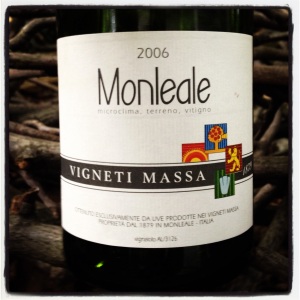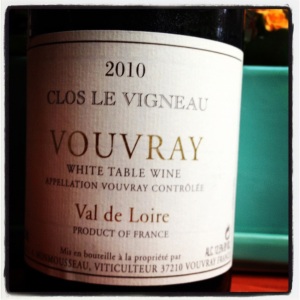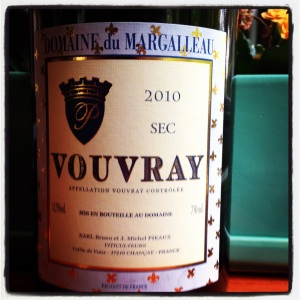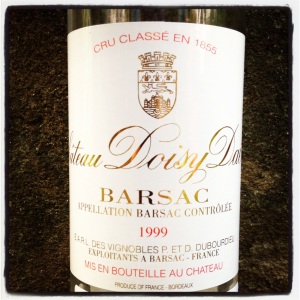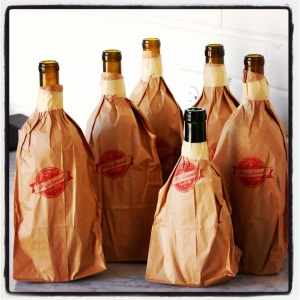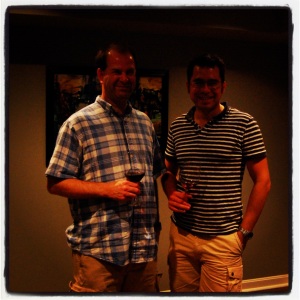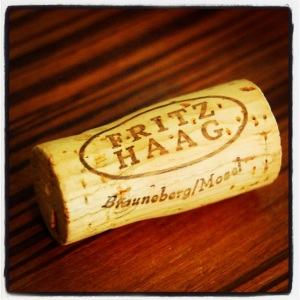Archive
Moselle, The Other Mosel
OK, I could not resist sharing how my friend introduced this bottle to me. It is easy to set focus on the Mosel River in Germany but one should not forget that it also flows through Luxemburg and France. The majority of the vineyards of Chateau de Vaux are located in the Cotes de Moselle which lie along the river south of Metz. Here the vines are located on hills with rocky terraces with chalky soils mixed with clay and limestone scree. A portion of the vineyards are located south in Vic-sur-Seille where the steep slope of the main hill provides good drainage for the heavy, clay and chalk soils. The estate began farming organically in 2009. If the name Chateau de Vaux sounds familiar it could be because we first drank the Alerions Brut back in February. While the Alerions was enjoyable this one is more my style. So shake up your normal rotation by drinking this selection. I found it drank well over several days. This wine was purchased at MacArthur Beverages.
2011 Chateau de Vaux, Les Gryphees, Moselle – $15
Imported by Potomac Selections. This wine is a blend of 30% Auxerrois, 30% Muller Thurgau, 30% Pinot Gris, and 10% Gewurztraminer. Each varietal is harvested separately then fermented in temperature controlled tanks. Alcohol 12% vol. The color is light+ straw with copper highlights. The nose is of lemon-citrus with tropical undertones. In the mouth the light yellow fruit becomes more tropical as it is worked in the mouth revealing tropical and passion fruit flavors. There are slate-like flavors to this fresh wine which is lively on the tongue. The acidity in the middle subdues then comes back with strength in the aftertaste. *** Now-2015.
The Exciting 2006 Vigneti Massa, Monleale
Even though we have tasted through a variety of dessert wines we have not neglected our reds. It was an easy decision to start this week’s red wine posts with this fun bottle. The wines of Vigneti Massa are the work of Walter Massa. Vigneti Massa is based in the town of Monleale in the zone of Colli Tortonesi. This zone is located beneath Alba in the extreme south-east corner of Piedmont. At the hill-top town Moneale Alto the soils are of clay, chalk, stone, and sand at an altitude of 200-300 meters. Both of us rather enjoyed this bottle. It took an hour or two to progressively open up. Upon completion of the bottle I realized how generous the flavors had become. So if you drink it now be sure to decant it to best show off the bottle age. While I do not mind the rustic power of the tannins others might prefer to drink it with food. This bottle was purchased at MacArthur Beverages.
2006 Vigneti Massa, Monleale, Colli Tortonesi – $25
Imported by Porto Vino Italiano. This wine is 100% Barbera sourced from the 1.25 hctare Bigolla vineyard planted in 1965 and 1968, the 1.4 hectare Campolungo vineyard planted in 2002, and the 1.28 hectare Fontana vineyard planted in 1978 and 1984. The fruit from the vineyards are vinified separately then aged for 22 months in 228 liter barriques. Alcohol 14.5% vol. The color is a medium garnet. The nose is evocative of a dry-port and is taking on secondary aromas. In the mouth there is red fruit, maturing flavors, dryness, and plenty of balanced acidity. There are slightly ripe chewy tannins which coat the teeth. There is good weight, tang, and the sense of approaching mid-life but should develop and last for some time. This offers up a lot of flavor. *** Now-2025.
The Solid 2005 Chateau Liot
Chateau Liot is a property located in Barsac near Chateau Climons. It has been in the David family for five generations and is currently run by Jean-Gerard David. The estate produces wine from 20 hectares of vineyards planted with 85% Semillon, 10% Sauvignon, and 5% Muscadelle. The vines are located on gravel, silt, alluvial soils on top of limestone bedrock. The fruit is fermented in vat then matured for 15-18 months in 15% new oak barrels. This was a solid enough Sauternes, pleasing but not exciting. At $19 per half-bottle I would recommend spending an extra $4 to update to the 2007 Chateau Sigalas Rabaud. This wine was purchased at Wide World of Wines.
2005 Chateau Liot, Sauternes – (375 mL) $19
Imported by Ginday Imports. Alcohol 14%. The flavors start off with peach and yellow fruit followed by a touch of black tea. It opens up to reveal fresh apple notes with an autumnal mix of cinnamon. There is a light to moderate sweetness. The aftertaste brings dried fruit. ** Now-2019.
Two Good Values from Vouvray
I recently asked Phil for some Chenin Blanc recommendations. He promptly suggested these two wines which are featured in this post. I must admit they are quite nice for the price. Similarities include floral white fruit, ripeness, lively acidity, and minerals. From there the Monmousseau is a bit more soft and generous with the Margalleau showing rather energetic acidity. Why not try them both at the same time? You do not have to worry about finishing the bottles right away for the drink very well over several days in the refrigerator. These wines were purchased at MacArthur Beverages.
2010 Monmousseau, Clos de Vigneau, Vouvray – $15
Imported by Kysela Pere et Fils. This special cuvee is 100% Chenin Blanc sourced from vines averaging 35 years of age. Alcohol 12.5% vol. The color is a light straw-yellow. The light+ nose reveals melons and dry floral aromas. In the mouth there are initial ripe flavors which are a touch sweet then tangy acidity kicks it. The flavors are generously full with a mineral finish. This tastes young. *** Now-2017.
2010 Domaine du Margalleau, Sec, Vouvray – $14
Imported by DS Trading Company. This wine is 100% Chenin Blanc sourced from vines on clay-siliceaous soils with flint stones. It is fermented then aged on the fine lees in stainless steel tanks. Alcohol 12.5% vol. The color is a light straw-yellow. The light+ nose reveals floral white fruit with a light ripe texture, and aromas of ripe pear. In the mouth there is an immediate burst of fruit riding a wave of acidity then a fresh, gentle ripeness. There is good, not quite creamy, body and acidity on the tip of the tongue. The flavors are of floral fruit in the middle and stones in the finish. *** Now-2016.
“What Lucy Found There”
And when Lucy was tired of eating, the Faun began to talk. He told her about…summer when the woods were green and old Silenus on his fat donkey would come to visit them, and sometimes Bacchus himself, and then the streams would run with wine instead of water and the whole forest would give itself up to jollification for weeks on end.
(16-17, Ch. 2), C.S. Lewis, The Lion, The Witch, and The Wardrobe, Harper Entertainment, NY, NY, 2005.
A Close Look at the Wines of The Williamsburg Winery
Last year we celebrated Independence Day by attending the Blues, Brews, and BBQ Party at the Williamsburg Lodge. Rather thunderstorms rolled in, everything was cancelled, and then we returned to our hotel rooms. It was not a complete disaster as I was surprised by the wines poured: 2006 Williamsburg Winery, Governor’s White and 2003 Williamsburg Winery, Arundell, Cabernet Sauvignon. They were actually rather decent! Thus on my inaugural visit to The Williamsburg Winery I knew I had to purchase some older vintages to try along with more current selections.
After participating in a Basic Tasting I stopped by the wine store to purchase six bottles. Both the online and winery stores maintain an extensive list of older vintages. There are bottles of Chardonnay back to 1988 which one may buy and Cabernet Sauvignon back to 1989. I tried to balance vintage strength against affordability in coming up with my six bottle selection. The 1994 and 1995 vintages were produced by former winemaker Steve Warner. The 2005 and 2007 vintages were produced by current winemaker Matthew Meyer.
2007 – The best year I have witnessed in Virginia so far. The growing conditions were perfect with little to no rain during harvest. The total rain fall for August-October was approximately 9.5 inches. Rating – Exceptional
2005 – An excellent year for both red and whites. The rains held off during crush and we had consistent temperatures throughout the growing season. Rating – Excellent
1995 – A dry, hot summer. Bold ripe fruit. Not as complex as 1997. Rating – Excellent
1994 – Some rain through summer. elegant Whites. Well-structured Reds. Rating – Very Good
Excerpted from A Review Of Past Vintages, The Williamsburg Winery
This week we gathered at Lou’s house to taste the wines and I suppose to also swim in the pool and eat. Lou is curious so he promptly agreed to let me provide the red wines blind. The 2005s and 2007s were double-decanted at my house and had 1.5 hours of air before tasting. The 1994 and 1995 were decanted at Lou’s house and had 15 minutes of air before they were tasted.
The 1994 and 1995 were completely past prime and barely drinkable which is a shame given the price of the 1995. The 2007 vintage with its increased flavors does appear to be a step above the 2005. Both of these vintages improved with air and I believe smelled their best on the second day. My favorite wine was the 2007 Trianon which struck the best balance of dark fruit, acidity, and structure for near term development. The flavors of the 2007 Merlot Reserve are richer than the 2005, but the 2007 has ample tannic structure requiring short-term aging.
While we got settled in we started off with a white wine which Lou poured blind. Weygandt Wines had a few bottles of this so Lou picked one up to try. Amazingly, Adriene guessed it was made of Roussanne! I thought it was a Chardonnay from Jura.
2004 Alban Vineyards, Roussanne, Edna Valley – $30
The color was vibrant golden straw. The nose was oxidative at first then it blew off to reveal finely textured apple orchard notes with underlying aromas of delicate tropical fruit. In the mouth there was good texture, lightly creamy at first then oily, with some tannic notes. The flavors expand in the mouth with a refreshing finish. There was lots of salivating acidity in this balanced, fully mature wine. This opened up nicely over an hour. *** Now-2014.
1994 Williamsburg Winery, Cabernet Sauvignon – (375 mL) $6
This wine was aged for 12 months in oak. This was a light+ brick color which looked aged! The nose was minty fresh, a touch underripe. In the mouth the hard red fruit was dried out followed by a minty aspect. There was a little bit of watery acidity and some texture. Not Rated, Past.
1995 Williamsburg Winery, Merlot Reserve – $48
This wine was aged for 12 months in oak. The color was lighter than the 1994 and was tawny. There was an old, musty nose. Perhaps a bit more body but musty flavors with old perfume in the aftertaste. Not Rated, Past.
2005 Williamsburg Winery, Merlot Reserve – $28
This wine is 100% Merlot which was fermented in stainless steel with a proportion undergoing malolactic fermentation. It was aged for 18 months in French and American oak. Alcohol 12.8% vol, pH 3.61, TA 6.07 g/L. The color is a medium, ruby purple. The tight nose starts off a little foxy then eventually takes on higher-toned red fruit. In the mouth there is a good smooth body which is a little racy. The flavors are a bit mouthfilling with flavors of cherry and some wood. There was a little bit of heat on the first night in the aftertaste. This shows structure at this point with fine+ grippy tannins which are starting to resolve. ** Now-2015.
2005 Williamsburg Winery, Trianon – $36
This wine is a blend of 80% Cabernet Franc, 10% Petite Verdot, and 10% Cabernet Sauvignon which was fermented in stainless steel with a proportion undergoing malolactic fermentation. It was aged for 18 months in French and American oak. Alcohol 12.7% vol, pH 3.59, TA 5.55 g/L. The color is a light to medium ruby. The light fresh nose reveals greenhouse aromas and a pepper note. In the mouth the drier red fruit follows the nose with more tannins and some dark red fruit. With air the red berries take on brighter and higher-toned flavors. There is a fair amount of structure and fine drying tannins. * Now-2015.
2007 Williamsburg Winery, Merlot Reserve – $28
This wine is a blend of 88% Merlot and 12% Petit Verdot which was fermented in stainless steel with a proportion undergoing malolactic fermentation. It was aged for 18 months in French and American oak. Alcohol 12.7% vol, pH 3.72, TA 5.66 g/L. The color is a medium+ purple ruby. The light nose has more berry nose and with air fresh-cut grass. In the mouth there is an old perfume note, greenhouse notes, and a touch more concentration than the 2005. It is a somewhat savory with a bit more richness, plenty of structure along with ample fine drying tannins and wood box notes in the aftertaste. With air the flavors tilt towards cranberry. ** Now-2017.
2007 Williamsburg Winery, Trianon – $32
This wine is a blend of 80% Cabernet Franc, 15% Merlot, and 5% Petit Verdot which was fermented in stainless steel with a proportion undergoing malolactic fermentation. It was aged for 18 months in French and American oak. Alcohol 13.7% vol, pH 3.83, TA 5.96 g/L. The color is a medium ruby purple. The light to medium nose has a strange scent at first but then takes on red berries and oak. The mouth follows the nose and is a touch savory with good flavors which expand in the mouth. The dark fruit, wood box, and a drying aftertaste. ** Now-2018.
Tasting Wine At the Williamsburg Winery
After our Independence Day holiday at Colonial Williamsburg we stopped by The Williamsburg Winery. The 320 acre estate is located only several miles from Colonial Williamsburg next to the James River. Purchased in 1983 by Patrick and Peggy Duffeler planted Chardonnay, Seyval Blanc, Merlot, and Cabernet Sauvignon from 1985-1988. In the early 2000s those vines were pulled up to allow planting in 2003 of different clones of Merlot, Vidal Blanc, Petit Verdot, and Traminette. Most recently Viognier was planted in 2009 with Cabernet Franc and Malbec in 2010. There are now some 50 acres of vineyards. The estate produces wine from mostly estate fruit but also sources from 12 vineyards in Monticello and Loudon County.
With the Reserve Tasting fully booked we decided to do the basic tasting. At the low-end the 2009 Arundel,Cabernet Sauvignon is both approachable and affordable. In the mid-range the 2010 Acte 12, Chardonnay gets a floral boost from the addition of Traminette and should appeal to many. The 2006 Gabriel Archer Reserve reveals tangy, cranberry flavors which are focused and chewy.
2011 Williamsburg Winery, Dry Rose – $12
This wine is a blend of 94% Merlot, 3% Traminette, and 3% Vidal Blanc. There was a very berry nose. In the mouth the tart red fruit flavors were very dry with high acidity, perhaps a touch of tannins, and a decent finish.
2010 Williamsburg Winery, Acte 12, Chardonnay – $18
This is a blend of 97% Chardonnay and 3% Traminette which includes non-estate fruit. It was primarily barrel-fermented and aged. The richer yellow nose contained some floral hints and ripeness. In the mouth it was moderately fresh with some tart fruit, some wood notes, and a bit of weight.
2010 Williamsburg Winery, Traminette – $18
This is 100% Traminette which was sourced from estate vineyards. It was fermented in stainless steel then aged in French oak barrels. The nose was very floral with tropical aromas and sweet honey. There is a touch of residual sugar followed by tea notes mixed with yellow fruit. The black tea aspect is a bit heavy.
2009 Williamsburg Winery, Arundel, Cabernet Sauvignon – $11
This wine is blend of 75% Cabernet Sauvignon, 12.5% Cabernet Franc, and 12.5% Petit Verdot which was aged for 6-9 months in American and French oak barrels. The nose reveals greenhouse aromas with pepper notes. In the mouth the tight red berries make way to some blue notes. This is very approachable with mild tannins and a slightly racy aftertaste.
2007 Williamsburg Winery, Burgesses’ Measure, Merlot – $15
This is a blend of 90% Merlot and 10% Cabernet Sauvignon which was aged primarily in wood. The nose reveals greenhouse aromas with perhaps clove. In the mouth the tart red fruit shows more focus with obvious but nice tannins. There is old-school perfume in the dry finish.
2006 Williamsburg Winery, Gabriel Archer Reserve – $26
This is a blend of 34% Cabernet Franc, 21% Cabernet Sauvignon, 29% Merlot, and 6% Petit Verdot. The nose is light but reveals darker fruit. In the mouth the cranberry and tart red fruit flavors are integrated with acidity. The wine is tangy and a little bit chewy. This showed the most focus.
NV Williamsburg Winery, Vin Licoreaux de Framboise – $18
This is a blend of red wine and raspberry juice. The raspberry nose works well. In the mouth the are tart, pure raspberry flavors which are completely puckering. Interesting but very hard to drink. As suggested, best drizzled on things.
A Maturing Monbazillac
Monbazillac is located in South-West France due east of Bordeaux. Unlike the surrounding Bergerac all of the wines of Monbazillac are sweet. These wines are produced from mostly Semillon along with Muscadelle, and Sauvignon which have been affected by Botrytis. The vineyards of Monbazillac are located on hillsides overlooking the Dordogne Valley. There are some 2500 hectares of vineyards producing 10% of all wine in Bergerac. The appellation encourages the picking of ripest fruit by requiring the estates to harvest by hand over at least two tries.
Chateau Vari was bought by Bordeaux oenologist Yann Jestin in 1994. He restored the vineyards then converted to organic farming in 2009. He produces three Monbazillac cuvees from some 14.5 hectares of vines on soils of clay and some exposed limestone. The vines average 40 years of age. This Reserve du Chateau is the mid-level cuvee which is only made during exceptional years. This 2003 vintage is the fourth after 2001, 1998, and 1995. It is produced from fruit harvest over three tries.
This wine was certainly different from the others we have tried for it had a strong, mature and earthy aspect. I suspect it might be just past peak maturity for the mature aspect is becoming disjointed from the sweet, racy body. This will live on for quite some time but I would not hesitate to drink this sooner than later. This bottle was purchased at Wide World of Wines.
2003 Chateau Vari, Reserve du Chateau, Monbazillac – (375 mL) $15
Imported by Wide World of Wines. This wine is a blend of 90% Semillon, 5% Sauvignon, and 5% Muscadelle sourced from 45-year-old vines with south/southwest exposure. The fruit is fermented in barrique followed by 14 months of aging in barrel. Alcohol 13.5% vol. The color is an orange-amber reflecting age. The medium strength nose reveals mature, earthy aromas with mushrooms. In the mouth it tastes younger with racy, sweet flavors followed by rather spicy notes of dried apricot. It becomes heavier midpalate before older flavors come out. It is sweet and sticky in the aftertaste. ** Now.
An Uncrushable Wine from Weingut Fritz Haag
I continue my exploration of white dessert wines with this quite different wine. This is my second wine I have tasted of the 2010 vintage from Weingut Fritz Haag. The Haag vineyards were first mentioned in 1605. More recently Wilhelm Haag ran the estate from 1957 until 2005 when his son Oliver Haag took over. Oliver’s brother Thomas runs the nearby Schloss Lieser estate. Oliver produces wine from some 12.2 hectares of Riesling vineyards with this wine from the classified Brauneberger Juffer Sonnenuhr. The 10.5 hectare Brauneberger Juffer Sonnenuhr vineyard is located in the central part of 32 hectare Braunberger Juffer. The south-facing vines are located on weathered Devonian slate soils at slopes of up to 80%!!!
This beautiful wine has precise flavors which are carried through with great acidity. It is drinkable now but at this stage though very interesting in all aspects, it is quite young. I would recommend cellaring this at least five years before trying again. This bottle was purchased at MacArthur Beverages.
2010 Weingut Fritz Haag, Brauneberger Juffer Sonnenuhr, Rielsing Auslese, Mosel – (375 mL) $27
Imported by Rudi Wiest. This wine is 100% Riesling. Alcohol 7.5% vol. The color is a light yellow straw. The tighter nose is fresh and articulate with honeyed notes. In the mouth the flavors are precise with rich focused flavors and immediate lively acidity. There is weight of this wine with its lemon custard flavors. The texture is punctuated and carried up by almost effervescent white floral fruit with some honeyed weight. There is residual sugar in the finish followed by uncrushable acidity in the aftertaste. **** Now-2042.



